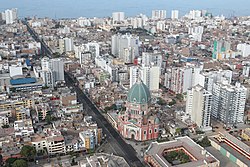Magdalena del Mar | |
|---|---|
 Aerial view in 2020, the Church can be seen | |
 Location of Magdalena del Mar in the Lima Province | |
| Coordinates: 12°06′S77°05′W / 12.100°S 77.083°W | |
| Country | |
| Region | Lima |
| Province | Lima |
| Founded | May 10, 1920 |
| Capital | Magdalena del Mar |
| Subdivisions | 1 populated center |
| Government | |
| • Mayor | Francis Allison (APP) (2023-2026) |
| Area | |
• Total | 3.61 km2 (1.39 sq mi) |
| Elevation | 58 m (190 ft) |
| Population (2023) [1] | |
• Total | 69,488 |
| • Density | 19,200/km2 (49,900/sq mi) |
| Time zone | UTC-5 (PET) |
| UBIGEO | 150120 |
| Website | munimagdalena.gob.pe |
Magdalena del Mar, also known simply as Magdalena, is a seaside district of Lima Province in Peru and one of the districts that comprise the city of Lima. Its current mayor is Francis Allison Oyague. Magdalena was officially established as a district on May 10, 1920.

